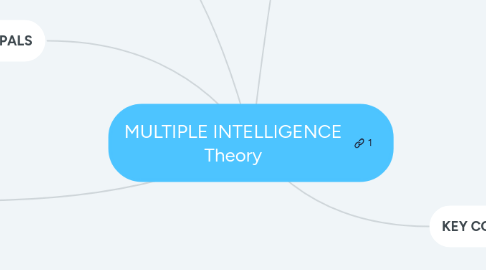
1. PRINCIPALS
1.1. Individuals naturally have different strengths in learning
1.2. Individuals have different cognitive profiles
1.3. Every brain is unique
2. ELEMENTS
2.1. Bridges Cognitive Psychology and Education
2.2. To be categorized as intelligence has to have characteristics of eight elements
2.2.1. 1. Identifiable cerebral systems; 2. Evolutionary history and plausibility; 3. Core set of operations; 4. Meaning encoded in a symbol system; 5. A distinct developmental history & mastery; 6. Savants, prodigies, and exceptional people; 7. Evidence from experimental psychology; 8. Psychometric findings.
3. IMPLICATIONS FOR CLASSROOM
3.1. INSTRUCTIONAL APPROACHES
3.1.1. Each Intelligence can be used to deliver information
3.2. Differentiate Assessments
3.2.1. Show Understanding in a Variety of Ways
3.3. Customize Curriculum
3.3.1. Teach Standards in a Variety of Ways
3.4. Customize Instruction
3.5. Personalized Education
4. BASIC ASSUMPTIONS
4.1. Appealing to different learning styles can increase learning.
4.2. Different individuals have different learning preferences.
4.3. Standardized testing doesn't accurately show results for student's growth.
4.4. Minds have different parts and do different things well.
4.5. Not everyone has to do the same things well.
5. KEY COMPONENTS
5.1. Interpersonal
5.1.1. Core Cognitive Units
5.1.1.1. Social Perception Interpersonal Understanding Social Effectiveness Leadership
5.1.2. Primary Regions
5.1.2.1. Frontal Temporal Cingulate Parietal
5.2. Intrapersonal
5.2.1. Core Cognitive Units
5.2.1.1. Self-Awareness Self-Regulation Executive Functions Self-Other Management
5.2.2. Primary Regions
5.2.2.1. Frontal Cingulate Temporal Parietal Subcortical
5.3. Logical-Mathmatical
5.3.1. Core Cognitive Units
5.3.1.1. Mathematical Reasoning Logical Reasoning
5.3.2. Primary Regions
5.3.2.1. Frontal Parietal Temporal
5.4. Linguistic
5.4.1. Core Cognitive Units
5.4.1.1. Speech Reading Writing Multimodal Communication of Meaning
5.4.2. Primary Regions
5.4.2.1. Temporal Frontal Parietal
5.5. Spatial
5.5.1. Core Cognitive Units
5.5.1.1. Spatial Cognition Working with Objects Visual Arts Spatial Navigation
5.5.2. Primary Regions
5.5.2.1. Frontal Parietal Temporal Occipita
5.6. Musical
5.6.1. Core Cognitive Units
5.6.1.1. Music Perception Music and Emotions Music Production
5.6.2. Primary Regions
5.6.2.1. Frontal Temporal Subcortical Cerebellum
5.7. Kinesthetic
5.7.1. Core Cognitive Units
5.7.1.1. Body Awareness/Control Whole Body Movement Dexterity Symbolic Movement
5.7.2. Primary Regions
5.7.2.1. Frontal Parietal Subcortical Cerebellum
5.8. Naturalistic
5.8.1. Core Cognitive Units
5.8.1.1. Pattern Cognition Understanding Living Entities Understanding Animals Understanding Plant Life Science
5.8.2. Primary Regions
5.8.2.1. Temporal Subcortical

